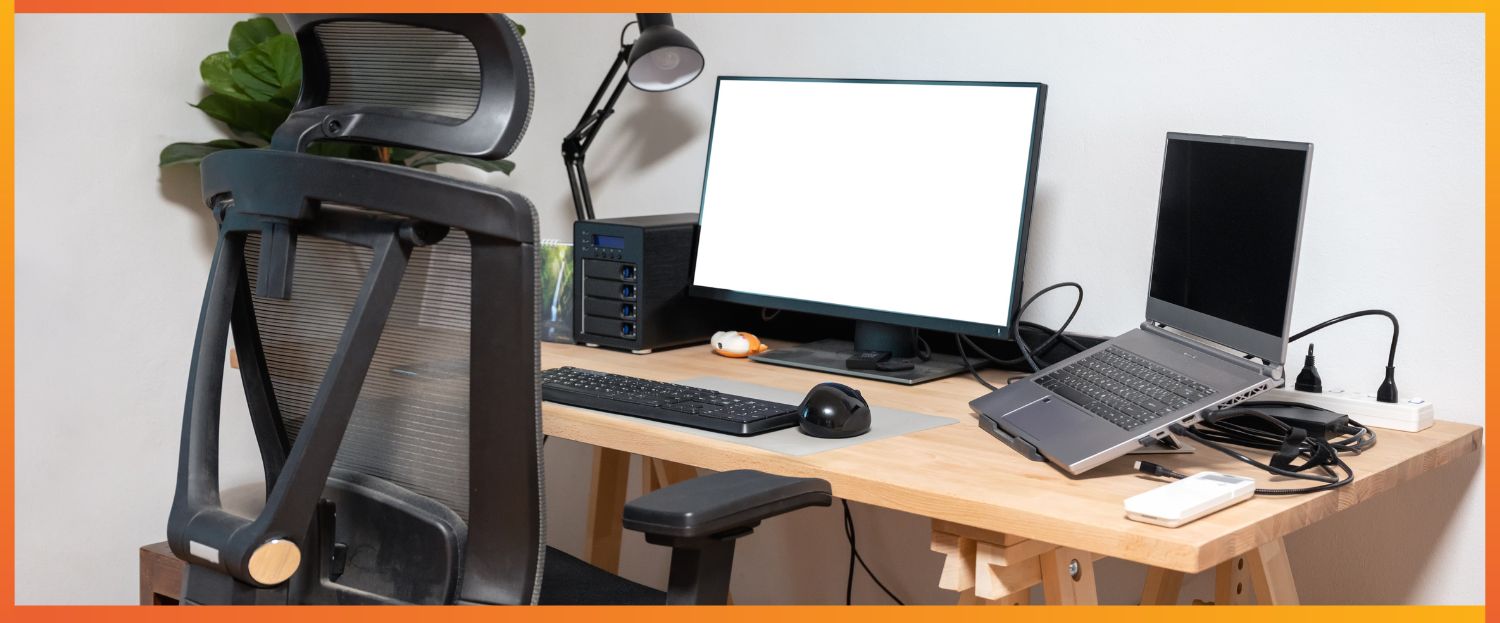9 Simple Ways To Make Your Office Chair More Comfortable
Spending hours in an office chair each day can lead to discomfort, poor posture, and reduced productivity, especially if your workspace isn’t set up ergonomically. We’ve written this guide to address these common challenges and provide practical solutions. Whether you’re adjusting an existing office chair or looking to enhance your setup with ergonomic tools, this article will help you transform your office chair into a supportive, comfortable seat.
We’ve compiled a list of nine actionable tips that target key areas like posture, movement, and customisation. From adjusting chair height to adding accessories, each section is packed with expert advice to improve your comfort and well-being.
Let’s get started on making your workday more enjoyable and productive.

1. Adjust the Chair Height
Proper chair height is fundamental for maintaining good posture and reducing strain on your body. Start by ensuring that your feet rest flat on the floor. Your knees should be at a right angle or slightly lower than your hips to promote healthy blood circulation and reduce pressure on the lower back.
Adjust your chair height so that your elbows form a 90-degree angle when resting on your desk. This alignment supports your shoulders and minimises strain on your arms and wrists. If your feet cannot reach the floor, invest in a footrest to provide the necessary support. By optimising chair height, you create a stable foundation for your posture and reduce the risk of discomfort or injury over time.
2. Enhance Lumbar Support
Lower back discomfort often results from a lack of adequate lumbar support in office chairs. Start by choosing a lumbar support cushion designed to follow the natural curve of your lower back. High-density memory foam options work best, providing consistent support and adapting to your body’s contours. If you’re on a budget, a rolled-up towel or a small cushion can also be effective.
For chairs with built-in lumbar support, adjust the setting to match the curvature of your spine. Ensure the support sits firmly against your lower back without being too rigid. This helps maintain the spine’s natural "S" shape, prevents slouching, and minimises strain, making long hours of sitting more manageable.
3. Add a Seat Cushion
Prolonged sitting can cause discomfort, especially if your chair lacks adequate padding. Adding a high-quality seat cushion is a simple way to enhance your chair’s comfort and support.
Opt for cushions made from memory foam or gel, as these materials evenly distribute your weight and help prevent pressure points. Ensure the cushion is firm enough to maintain proper posture but soft enough to relieve discomfort. A well-chosen seat cushion can also help align your hips and pelvis, reducing strain on your lower back during long hours at your desk.
4. Adjust the Armrests

Armrests play a vital role in supporting your shoulders and arms, helping to reduce strain and improve overall posture. Start by setting the height so your elbows rest naturally at a 90-degree angle, allowing your forearms to remain parallel to the ground. This position ensures that your shoulders stay relaxed rather than hunched, which can lead to tension over time. Additionally, adjust the armrest width to keep your arms comfortably close to your body, promoting a neutral posture.
If your chair lacks adjustable armrests, you can enhance comfort by adding padded armrest covers. These provide extra cushioning and support, ensuring a more ergonomic setup that minimises shoulder and arm fatigue during long work sessions.
5. Ensure Proper Recline and Tilt
Maintaining a rigid upright position for hours can lead to significant strain on your back and neck. Introducing a slight recline to your chair reduces spinal pressure and encourages better posture.
Adjust your backrest tilt to provide adequate support for both your upper and lower back. Aim for a recline angle of 100 to 110 degrees, as this range is considered optimal for comfort and spinal alignment. Proper reclining promotes movement and helps distribute weight more evenly, preventing discomfort over extended periods of sitting.
6. Upgrade Your Wheels
Old or incompatible chair wheels can make movement cumbersome and cause unnecessary strain on your body. To improve mobility and reduce effort, replace worn-out wheels with casters or gliders suited to your flooring type.
Hard wheels work best on carpets, providing smooth rolling without resistance, while soft wheels are ideal for hard surfaces like wood or tile, preventing scratches and noise. Ensuring your chair moves effortlessly can significantly enhance comfort and ease throughout your workday.
7. Use Ergonomic Accessories
Incorporating ergonomic accessories into your setup can significantly enhance the comfort and support provided by your chair. A footrest is an excellent addition, especially if your feet don’t comfortably reach the floor. It improves circulation, reduces strain on your legs, and encourages better posture.
For those who spend long hours typing, a wrist pad is invaluable. It minimises strain on your wrists, helps maintain a neutral hand position, and reduces the risk of repetitive strain injuries.
If you frequently recline in your chair, consider adding a headrest. This accessory provides critical support for your neck, alleviating tension and preventing stiffness during extended periods of work or rest. By strategically using these ergonomic tools, you can create a more comfortable and health-conscious workspace.
8. Customise Your Workspace

Your chair’s comfort is heavily influenced by the overall setup of your workstation. To achieve an ergonomic workspace, start by positioning your monitor so the top of the screen is at or slightly below eye level. This alignment minimises neck strain and promotes a natural viewing angle.
Next, adjust your keyboard and mouse so they are at elbow height. This setup helps maintain a neutral position for your arms and wrists, reducing the risk of repetitive strain injuries. Finally, ensure that frequently used items, such as your phone or notepad, are within easy reach. This prevents unnecessary overextension and promotes a more efficient and comfortable workflow.
9. Take Breaks and Move Regularly
Even the most comfortable chair cannot compensate for the negative effects of prolonged sitting. To counteract this, make a habit of incorporating regular movement into your day. Aim to stand up and stretch at least every 30 minutes to alleviate muscle tension and improve circulation. Periodic walks around your workspace can further reduce stiffness and keep your body active.
Consider using a sit-stand desk to alternate between sitting and standing throughout the day. This setup promotes dynamic movement and helps prevent the physical strain associated with remaining in one position for too long. Regular breaks and movement are essential for both physical health and mental focus.
Final Thoughts
Creating a comfortable seating arrangement doesn’t require an expensive new chair. By making thoughtful adjustments and using well-chosen accessories, you can significantly improve your sitting experience. From optimising chair height to adding ergonomic tools, each step contributes to better posture, reduced discomfort, and enhanced productivity.
Remember, the goal is to create a setup that supports your body and encourages healthy habits throughout the day. Start by implementing just one of these tips, and notice the difference it makes. Over time, incorporate more changes to fully optimise your workspace.
Now it’s your turn to take action. Begin transforming your chair and workstation today for a healthier and more productive work experience.






